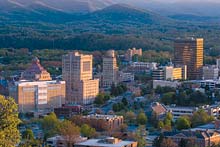Last August, the call went forth. Asheville’s Office of Economic Development issued a Request for Qualifications from firms that could guide a new Downtown Master Plan for the city, building on the existing City Center Plan of 2002.

Qualified consultant teams “in the areas of citizen involvement/participation, visioning, planning, and sustainable community design” were sought, and the responses were plentiful. By the Nov. 8 deadline, some 25 firms (a “veritable who’s who,” as one local architect put it) from around the country and Canada had followed up on the chance to help shape Asheville’s future.
The shortlist was announced on Dec. 7, with six firms still in the running (see below). “They’re great,” says Stephanie Monson, urban planner for the OED, who managed the application process. “We tried to pick the best of the best. Out of six top firms, three are larger, or mature firms; three are more emerging, or smaller firms. So we have a good diversity of types.”
Proposed by the Downtown Commission, the Master Plan project is being guided by an advisory council made up of city and county staff along with the commission members. That council will spend the next month researching and interviewing the top six respondents, with a final choice expected in late January.
Monson said the committee looked for related work that shows depth of technical experience, innovation and interdisciplinary talent. Also key was an understanding of politics and activism in downtown Asheville.
The purpose of the master plan, according to the RFQ, is to compile a unified development document to guide five to 20 years of sustainable growth, “continuing Asheville on its path towards being the premier small city in the nation for urban livability.”
“We don’t need ‘cookie cutter’ solutions; we need innovative and artisan-like attention to our city,” applicants were advised. And their responses embraced the concept. Following is the list of the finalists with a selection of response comments, examples of related projects, and the local or regional “partners” included in their formal replies:
• Chan Krieger Sieniewicz, Cambridge, Mass: “The City’s own past efforts show a demand for visionary and integrative thinking. … We recognize the requirement for an approach that is sophisticated and advanced yet sensitive to the quirks and nuances of Asheville itself.” Project examples—the South Elm Street Redevelopment Plan in Greensboro, N.C.; the Knoxville Waterfront Vision and Action Plan. Proposed partner—Kubilins of Charlotte.
• Design Workshop, Asheville: Response themed “Community Supported Design” described an integrated process to inform good planning for “Asheville’s artisan-like patchwork of cultural and architectural diversity.” Projects—managing the student-internship master plan for Asheville’s River Arts District; the North Lake Tahoe [Calif.] Tourism and Community Investment Master Plan. Partner: Justice and Sustainability Associates, Washington, D.C.
• Goody Clancy, Boston, Mass.: Noting “the energy of downtown Asheville today,” a new plan should honor the city’s “unique character,” attracting new investment, residents and visitors while creating a sustainable environment. Project examples—Emory University [Atlanta] Urban Design Guidelines; Unified New Orleans [La.] Plan, post-Katrina. Proposed partners—Kimley-Horn and Associates, Raleigh, N.C., and Mary Means and Associates, Alexandria, Va.
• InFORM Studio, Northville, Mich.: Asheville [is] a “genuinely special opportunity” for its environmental wealth, cultural richness and economic diversity. Sustainability would require “application of diverse disciplines towards innovative methodologies” to provide a “symbiotic relationship between the three.” Projects examples—the Downtown Revitalization plan for Elizabethton, Tenn.; W.T. Weaver Boulevard’s urban greenway in Asheville. Partner—McGill Associates, Asheville.
• 180 Degrees Design Studio, Kansas City, Mo.: Ask citizens of Asheville to “redefine sustainability in an innovative fashion” through the triple lenses of ecology, economy and equity, nurturing small businesses, promoting balance between local creativity and national expertise and bringing the city and nature into harmony. Project examples—Evanston [Ill.] Downtown Master Plan; Walkable Towson [Md.]. Partners—Allison Ramsey Architects, Asheville; ecobuilder, Asheville and others.
• Sasaki, Watertown, Mass.: “Timely opportunity for orchestrating change over the next 10 to 20 years, in order to project smart growth in the region, the benefits and attractions of living downtown … while defining infill development potential that can support more green and sustainability.” Project examples: University of South Carolina’s Innovista Master Plan (Columbia, S.C.); Providence [R.I.] 2020 Plan. Partner: Rose and Associates, Davidson, N.C.
Once selected, the finalist is expected to review existing city plans, work with the Master Plan Advisory Committee and hold a series of charettes and public meetings in the first half of 2008. The draft plan would then include a “comprehensive guide for Downtown development that fosters sustainable economic growth,” evaluates public infrastructure, strengthens linkages to surrounding neighborhoods and provides regulatory recommendations.



Before you comment
The comments section is here to provide a platform for civil dialogue on the issues we face together as a local community. Xpress is committed to offering this platform for all voices, but when the tone of the discussion gets nasty or strays off topic, we believe many people choose not to participate. Xpress editors are determined to moderate comments to ensure a constructive interchange is maintained. All comments judged not to be in keeping with the spirit of civil discourse will be removed and repeat violators will be banned. See here for our terms of service. Thank you for being part of this effort to promote respectful discussion.